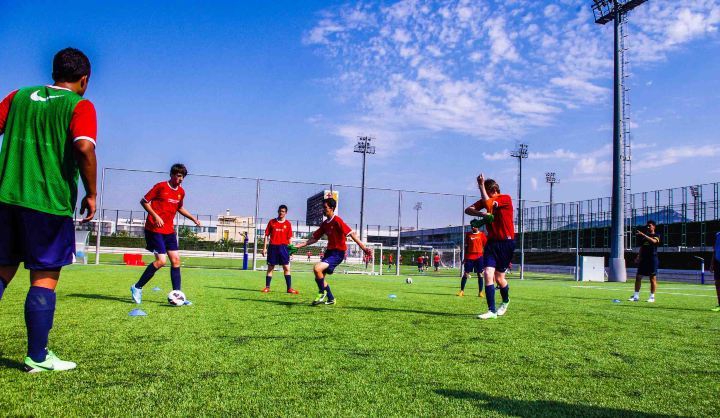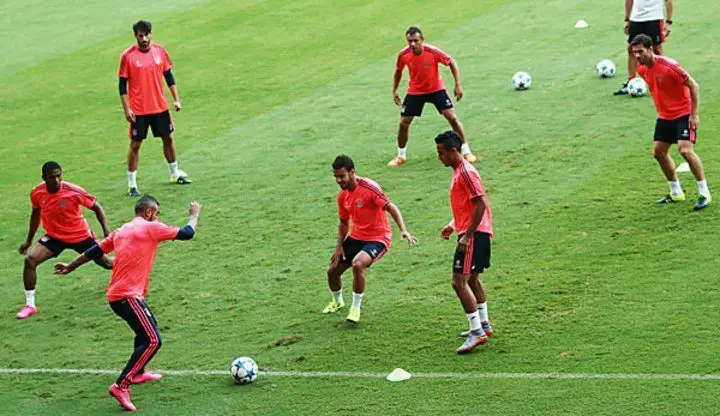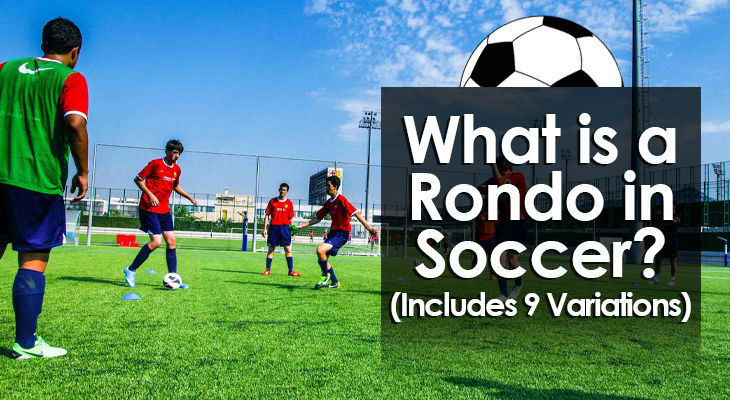What is a Rondo in Soccer? (Includes 9 Variations)
A great drill to use when your team is warming up or is having a training session, the “rondo” is loads of fun and teaches players to protect the ball and retain possession.
Players need to switch on and focus mentally if they are to keep the ball circulating since the game is played at such a quick pace.
The aim is to keep the ball for as long as possible without it being intercepted by the players in the middle.
To keep things interesting, there are many different variations for coaches to choose from with different learning outcomes for each of them.
Videos of rondos are always surfacing and the Barcelona players' amazing metronomic and casual one touch play to keep the ball circling is breathtaking to behold, and a healthy mix of tricks and flicks are often casually thrown in to boot.
Here’s a terrific example:
While the professionals can almost do it without thinking, youth players around the world can learn a lot from rondos and there are loads of skills which they can learn from them.
Here are nine rondo variations for you to try out and take your team’s game to the next level.
What is a Rondo and What are the Benefits?
Simply put, the rondo is a game where you have a group of players with a numerical advantage trying to keep the ball away from their opponents for as long as possible.
The objective is for the players with the ball to keep it within their team without the players in the middle intercepting it.
Many teams use this at the beginning of a training session or before a match to help players switch on and pay attention to their use of the ball.
While the number of players involved varies, you will often see 3v1 rondos or 5v2 or 7v3 and sometimes the whole team will be involved.
In contrast to other possession games where the players can move about and create space with their off the ball movement, in the rondo players have a set space that they occupy, and this means that they have to think on their feet to make sure they're not caught in possession.
By reacting quickly to any pass you receive, you can position your body and open it up in a way that means you can cushion the ball to a teammate in space.
Alternatively, you can shimmy or throw your opponent a dummy before passing it in the opposite direction.
There are a myriad of ways in which you can set up the rondo, and some of them allow you a couple of touches while others focus on developing your one touch play.
Yet others look to improve your control as you receive the ball under pressure and need to make sure that you take it away from the opponent closing in on you in one swift movement.
In general, rondos help with your decision making, creativity, passing abilities, and overall teamwork although there are a plethora of other skills which you'll also develop through playing this fun game.
A perfect warm up game or training drill, the rondo in all of its forms will certainly help you to develop as a player.

Here are a few ways you can set up the exercise:
Rondo One
Incorporating passing, control, movement and communication into one great drill, this exercise will really test your players' abilities as they need to focus and concentrate to successfully carry it out.
Start with two 15x30 areas and 10 players involved in the game.
Divide them into two teams of 5 players, each with their own area.
One team of five starts off with the ball and the opposition are allowed to send two of their players into the their opponent's area to regain the ball and win it back.
Upon winning the ball, they can then pass it back to their teammates in their own half and then they need to sprint back to provide their teammates with passing options as they will now be under pressure from the two opponents sent to win the ball back.
With only one touch available to the players, they need to think quickly and make split-second decisions time and time again if their team is to keep the ball for as long as possible.
Players need to constantly move to open up passing angles as well as width and depth to their teammates and their objective is to keep the ball for as long as possible.
Rondo Two
This rondo tests each player’s ability to keep calm under pressure, rotate the ball while being closed down, and hit an accurate long ball to a teammate.
Two 15x30 zones are set up thirty metres apart with a line drawn in the middle between them.
In each zone there is one team of six players and at the beginning the line in the middle has another team of six players lined up on it.
After a coach kicks the ball to one of the groups in the area, play commences and the players have to reach 10 passes without it being intercepted by two of the players who have sprinted from the halfway line to try and win the ball.
If they manage to reach ten passes, they can work an opportunity to hit a long ball to the team waiting in the other area.
The other team waiting on the line can head the ball or block it if the long ball isn't accurate enough.
Once the team in the other area receives the ball then another two players from the midway line can engage and sprint into the box to try to win the ball back.
If they succeed then the teams change over and play starts again.
Rondo Three
Designed to improve players' ball retention, decision making, and spatial awareness, this fun rondo is easy to set up and will also help players to improve their teamwork and communication skills.
With an area of 30x30 set up and divided into quarters, two teams of seven start off in opposite boxes with two games of 5v2 going on at the same time.
While the aim of the game is to keep the ball for as long as possible, there are a couple of other things to bear in mind...
Teams have to move to another box once they reach a pre-determined number of passes such as five or seven without the ball being intercepted by a defender.
To spice up the game, players can only use one touch passes and gain points whenever they successfully manage to transition to a new quarter of the zone.
Rondo Four
Great for midfielders looking to work on their passing skills, ball control, and sense of spatial awareness, this rondo will help them to improve their game and is great fun to play as well.
To begin, set up a thirty metre diameter circle with a twenty diameter circle at its centre and divide nine players into three teams of three players with each group having their own ball.
To start off the rondo, each group should have one player at the centre of the innermost circle and the other two players located opposite each other on the outside of the larger one.
Starting off slowly, one of the players on the outside passes to their teammate in the middle who turns and passes it to their other teammate on the opposite side of the circle.
Here they need to take care to avoid the other two players in the centre who are receiving passes from their teammates.
While they can choose to do this in as few touches as they want to work on their turning and ball control in tight spaces, they can also choose to receive the ball and dribble around their opponents before passing it on.
A great way to make the rondo even more fun is to have one team of three acting as defenders.
Here the player in the innermost circle must try to stop the other two from playing by winning the ball or blocking their passes.
Their two teammates move to inside the larger circle and also try and prevent passes from reaching the two players at the centre of the circle, covering passes and blocking off passing angles.
To make it more competitive, teams can be rewarded points for how many times they manage to successfully pass the ball back and forth from one side to the other.

Rondo Five
A really fun rondo, this one will improve player communication and teamwork skills and there is a heavy emphasis placed on off the ball movement in this exercise.
After having set up a 20x20 square, you need three players to take up a position at three of the corners with one corner being left free.
Inside the square is a player whose job it is to tear about, put the players under pressure, and win the ball back by either tackling their opponent or intercepting their pass.
The players on the corners of the square can only pass to a player who is at a corner bordering theirs, and this means that they have to constantly pass and move to make sure that they provide a passing angle to their teammate.
If they don't sprint into position in time, their teammate risks losing the ball and ending up in the middle.
A very intense and energetic exercise, this rondo will certainly improve each player’s teamwork abilities and their off the ball movement.
Rondo Six
A very competitive rondo, this one focuses on players keeping the ball for as long as possible while their opponents snap at their heels to win it back.
After having set up a 30x30 box, divide the team into two groups of six and one group of three, with the latter being the ones who are meant to win the ball back.
One group of six remain static outside of the box and offers up passing angles while the other six move about within the box, making space for themselves and darting into space and away from the three opponents shadowing them and trying to intercept the ball.
Once the three defenders have won the ball back three times, they swap over and another three take their place.
While it is a very demanding ask for the defending team, their communication and teamwork skills will improve as they need to work in tandem to close down space and win the ball back.
Rondo Seven
Designed with central midfielders in mind who need to practice receiving the ball and turn under pressure to slot a pass to a teammate, this rondo will have them in the thick of the action with opposition players everywhere.
The 25x25 square has six players spread out towards the exterior of the grid with one midfielder in the centre whose job it is to move into space and pass the ball on to a teammate.
As three defenders will be buzzing about them, the midfielder needs to control the ball and take it away from them in one swift movement or simply play quick and accurate one touch passes.
Movement is key to gaining that half-second's advantage and the player must be very aware of what is going on around them.
Rondo Eight
A very intense rondo which offers up a challenging test to any player, this one sees two teams compete for supremacy against one another.
In a 20x30 grid, two teams of four attempt to keep possession and win the ball back from another while another neutral team of three players sides with whichever team has the ball, effectively creating a seven on four situation.
To gain points the team with the ball must string ten passes together without the opposition winning the ball back.
The momentum can swiftly change as the ball turns over and the opposition have the advantage of having three more players.
Players need to constantly move and be prepared to immediately start defending for their lives once the opposition win the ball back.Rondo Nine
Intended to improve a team’s ball retention and quick combination play, this rondo will quickly improve your players’ abilities and they’ll soon be overwhelming other teams out on the pitch with their quick reactions, decision making, and transition play.
The 20x20 square is divided into a grid of four equal boxes with one player of each team located and constricted to that area.
Two neutral players may float around as they please and it is up to them to move the ball around as quickly as possible.
The game starts when the coach kicks the ball in and one player on a team receives the ball which they then pass to one of the neutral players who has entered their box to create a two or three on one situation against the defending player.
Like this the two neutral players move the ball around the grid, passing to the players on the same team until one of the opposition players wins the ball back.
Play then starts over with the opposition team in possession of the ball.
Great fun to play, it is a high intensity rondo and the small spaces make for intricate and creative interplay.
Conclusion
As you can see, there are tons of variations of rondo out there.
Coaches can really get creative with them as there are a myriad of ways in which they can be incorporated into a training programme.
With each of them having different learning outcomes, players can improve their ball skills, work on their communication and teamwork abilities, and develop their pressing and off the ball movement, all while playing a fun and competitive game.
By starting off with easier rondos, coaches can slowly introduce new and more complicated exercises until the team is confident enough to have a go at something a bit harder.
With teams such as Barcelona and Ajax swearing by the rondo, this type of game is simply a must for aspiring coaches and players alike.
Further Reading: 123 Soccer Drills for All Ages and Skill Levels (With Images)

